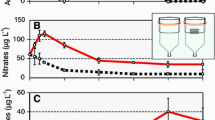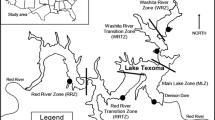Abstract
Over the past 10 years the golden mussel (Limnoperna fortunei), an exotic species native to eastern Asia, has become widespread and abundant in the Pantanal Wetland, Brazil. Oxygen concentrations are often low in rivers and floodplain waters of the Pantanal and oxygen depletion events can last for several weeks during the rising water phase. Although mortality of L. fortunei has been documented during oxygen depletion events, its tolerance to hypoxic and anoxic conditions is poorly understood, in part because changes in oxygen availability are accompanied by other changes such as decreased pH. We analyzed interannual variation in densities of adults and juveniles in relation to varying oxygen conditions, and tested the tolerance of L. fortunei to oxygen depletion events in a floodplain lake and in the laboratory. Mussels died after 5 days of an oxygen depletion event in a floodplain lake, and a population established there in 2005 was extirpated in 2006 owing to hypoxic conditions. Laboratory tests confirmed that mussels died more quickly in water from the oxygen depletion event. Annual oxygen depletion events must control the density of the invasive golden mussel in the Pantanal, maintaining low densities and periodically extirpating them from some habitats.







Similar content being viewed by others
References
APHA (2005) Standard methods for the examination of water and wastewater, 21st ed. In: Greenberg AE, Trussell RR, Clesceri LS (eds) American Public Health Association, American Water Works Association and Water Pollution Control Federation. Washington, DC, USA
Araújo R, Ramos MA, Bedoya J (1994) Microtubules in the shell of native invasive bivalve Corbicula fluminea (Muller, 1974) (Bivalvia: Heterodonta). Journal of Molluscan Studies 60:406–413
Benner R, Strom M (1993) A critical evaluation of the analytical blank associated with DOC measurements by high-temperature catalytic oxidation. Marine Chemistry 41:153–160
Boltovskoy D, Cataldo D (1999) Population dynamics of Limnoperna fortunei, an invasive fouling mollusc in the Lower Paraná River (Argentina). Biofouling 14:255–263
Boltovskoy D, Sylvester F, Otaegui A, Lentes V, Cataldo DH (2009) Environmental modulation of reproductive activity of the invasive mussel Limnoperna fortunei: implications for antifouling strategies. Austral Ecology 34:719–730
Calheiros DF, Hamilton SK (1998) Limnological conditions associated with natural fish kills in the Pantanal Wetland of Brazil. Verhandlungen des Internationalen Verein Limnologie 26:2189–2193
Callil CT, Mansur MCD (2002) Corbiculidae in the Pantanal: history of invasion in southeast and central South America and biometrical data. Amazoniana 17:153–167
Cantrell KJ, Serkiz SM, Perdue EM (1990) Evaluation of acid neutralizing capacity data for solutions containing natural organic acids. Geochimica et Cosmochimica Acta 54:1247–1254
Cataldo D, Boltovskoy D (1999) Population dynamics of Corbicula fluminea (Bivalvia) in the Paraná River Delta (Argentina). Hydrobiologia 380:153–163
Cataldo D, Boltovskoy D (2000) Yearly reproductive activity of Limnoperna fortunei (Bivalvia) as inferred from the occurrence of its larvae in the plankton of the lower Paraná River and the Rio de la Plata estuary (Argentina). Aquatic Ecology 34:307–317
Checa AG, Jimenez-Lopez C, Navarro-Rodriguez A, Machado JP (2007) Precipitation of aragonite by calcitic bivalves in Mg-enriched marine waters. Marine Biology 150(5):819–827
Chen LY, Heath AG, Neves RJ (2001) Comparison of oxygen consumption in freshwater mussels (Unionidae) from different habitats during declining dissolved oxygen concentration. Hydrobiologia 450:209–214
Darrigran G, Damborenea MC, Penchaszadeh P, Taraborelli C (2003) Reproductive stabilization of Limnoperna fortunei (Bivalvia Mytilidae) after ten years of invasion in the Americas. Journal of Shellfish Research 22:141–146
Deaton LE, Derby JGS, Subhedar N, Greenberg MJ (1989) Osmoregulation and salinity tolerance in two species of bivalve mollusk: Limnoperna fortunei and Mytilopsis leucophaeta. Journal of Experimental Marine Biology and Ecology 133:67–79
Gazeau F, Quiblier C, Jansen JM, Gattuso JP, Middelburg JJ, Heip HR (2007) Impact of elevated CO2 on shellfish calcification. Geophysical Research Letters 34. L07603. doi:10.1029/2006GL028554
Goto Y (2002) Behavior of nuisance mussel, Limnoperna fortunei, in water supply facilities. Water Sciences and Technology 46:45–50
Hamilton SK, Sippel SJ, Melack JM (1995) Oxygen depletion and carbon dioxide and methane production in waters of the Pantanal wetland of Brazil. Biogeochemistry 30:115–141
Hamilton SK, Sippel SJ, Melack JM (1996) Inundation patterns in the Pantanal wetland of South America determined from passive microwave remote sensing. Archiv für Hydrobiologie 137:1–23
Hamilton SK, Sippel SJ, Calheiros DF, Melack JM (1997) An anoxic event and other biogeochemical effects of the Pantanal wetland on the Paraguay River. Limnology and Oceanography 42:257–272
Hellings L, Dehairs F, Tackx M, Keppens E, Baeyens W (1999) Origin and fate of organic carbon in the freshwater part of the Scheldt Estuary as traced by stable isotope composition. Biogeochemistry 47:167–186
Johnson PD, McMahon RF (1998) Effects of temperature and chronic hypoxia on survivorship of the zebra mussel (Dreissena polymorpha) and Asian clam (Corbicula fluminea). Canadian Journal of Fisheries and Aquatic Sciences 55:1564–1572
Kempe S (1982) Long-term records of CO2 pressure fluctuations in fresh waters. SCOPE/UNEP Sonderband 52:91–332
Kleypas JA, Feely RA, Fabry VJ, Langdon C, Sabine CL, Robbins LL (2006) Impacts of ocean acidification on coral reefs and other marine calcifiers: a guide for future research, report of a workshop held 18–20 April 2005, St. Petersburg, FL, sponsored by NSF, NOAA, and the U.S. Geological Survey, pp 88
Mackie GL, Flippance LA (1983) Intra and interspecific variations in calcium content of freshwater mollusca in relation to calcium content of the water. Journal of Molluscan Studies 49:204–212
Magara Y, Matsui Y, Goto Y, Yusa A (2001) Invasion of the non-indigenous nuisance mussel, Limnoperna fortunei, into water supply facilities in Japan. Journal of Water Supply: Research and Technology–AQUA 50:13–24
Mansur MCD, Santos CP, Darrigran G, Heydrich I, Callil CT, Cardoso FR (2003) Primeiros dados quali-quantitativos do mexilhão-dourado, Limnoperna fortunei (Dunker), no Delta do Jacuí, no Lago Guaíba e na Laguna dos Patos, Rio Grande do Sul, Brasil e alguns aspectos de sua invasão no novo ambiente. Revista Brasileira de Zoologia 20:75–84
Marker AFH, Nush EA, Rai H, Rieman M (1981) The measurement of photosynthetic pigments in freshwaters and standardization of methods: conclusions and recommendations. Archiv für Hydrobiologie–Beiheft Ergebnisse der Limnologie 14:91–106
Matthews MA, McMahon RF (1999) Effects of temperature and temperature acclimation on survival of zebra mussels (Dreissena polymorpha) and Asian clams (Corbicula fluminea) under extreme hypoxia. Journal of Molluscan Studies 65:317–325
McMahon RF (1999) Invasive characteristics of the freshwater bivalve Corbicula fluminea. In: Claudi R, Leach J (eds) Nonindigenous freshwater organisms: vectors, biology and Impacts. CRC, Baca Raton, pp 315–353
Meese RJ, Tomich PA (1992) Dots on the rocks: a comparison of percent cover estimation methods. Journal of Experimental Marine Biology and Ecology 165:59–73
Mihuc TB, Battle JM, Mihuc JR, Bryan CF (1999) Zebra mussel (Dreissena polymorpha) seasonal colonization patterns in a sub-tropical floodplain river. Hydrobiologia 392:121–128
Montalto L, Marchese M (2003) Limnoperna fortunei (Dunker, 1857) (Bivalvia:Mytilidae) tolerance to temperature and pH in experimental conditions. Neotropica 49:26–34
Morton B (1975) The colonization of Hong Kong’s water supply system by Limnoperna fortunei (Dunker 1857) (Bivalvia: Mytilidea) from China. Malacological Review 8:91–105
Morton B (1977) The population dynamics of Limnoperna fortunei (Dunker 1857) (Bivalvia: Mytilacea) in Plover Cove reservoir, Hong Kong. Malacologia 16:165–182
Morton B (1982) The reproductive cycle in Limnoperna fortunei (Dunker 1857) (Bivalvia: Mytilidae) fouling Hong Kong’s raw water supply system. Oceanologia et Limnologia Sinica 13:312–325
Morton B (1996) The aquatic nuisance species problem: a global perspective and review. In: D’Itri FM (ed) Zebra mussels and other aquatic nuisance species. Ann Arbor, Chelsea, pp 1–54
Oliveira MD (2009) Factors controlling the density and potential distribution of golden mussel (Limnoperna fortunei Dunker 1857) in the Upper Paraguay Basin. Ph.D. Thesis, Universidade Federal de Minas Gerais (http://www.cpap.embrapa.br)
Oliveira MD, Takeda AM, Barros LF, Barbosa DS, Resende EK (2006) Invasion by Limnoperna fortunei (Dunker, 1857) (Bivalvia Mytilidae) of the Pantanal Wetland, Brazil. Biological Invasions 8:97–104
PCBAP (Plano de Conservação da Bacia do Alto Paraguai) (1997) Análise Integrada e prognóstico da Bacia do alto Paraguai. Programa Nacional do Meio Ambiente. PNMA, Brasília, Brazil. v.3, p 367
Rabalais NN, Turner RE, Wiseman WJ Jr (2002) Gulf of Mexico hypoxia, A.K.A. “The dead zone. Annual Review of Ecology and Systematics 33:235–163
Rabouille C, Conley DJ, Dai MH et al (2008) Comparison of hypoxia among four river-dominated ocean margins: The Changjiang (Yangtze), Mississippi, Pearl, and Rhone rivers. Continental Shelf Research 28:1527–1537
Ramcharan CW, Padilla DK, Dodson SI (1992) Models to predict potential occurrence and density of zebra mussel, Dreissena polymorpha. Canadian Journal of Fisheries and Aquatic Sciences 49:2611–2620
Rowe GT (2001) Seasonal hypoxia in the bottom water off the Mississippi River Delta. Journal of Environmental Quality 30:281–290
Saloom ME, Duncan RS (2005) Low dissolved oxygen levels reduce anti-predation behaviors of the freshwater clam Corbicula fluminea. Freshwater Biology 50:1233–1238
Stabel H-H (1986) Calcite precipitation in Lake Constance: chemical equilibrium, sedimentation, and nucleation by algae. Limnology and Oceanography 31:1081–1093
Takeuchi AT, Sarashina I, Iijima M, Endo K (2008) In vitro regulation of CaCO3 crystal polymorphism by the highly acidic molluscan shell protein Aspein. FEBS Letters 582:591–596
Valderrama JC (1981) The simultaneous analyses of total nitrogen and phosphorus in natural waters. Marine Chemistry 10:109–122
Yu N, Culver DA (1999) In situ survival and growth of zebra mussels (Dreissena polymorpha) under chronic hypoxia in a stratified lake. Hydrobiologia 392:205–215
Zhang SR, Lu XX, Higgitt DL, Chen CTA, Sun HG, Han JT (2007) Water chemistry of the Zhujiang (Pearl River): natural processes and anthropogenic influences. Journal of Geophysical Research 112:1–17
Acknowledgments
The work was supported by the Brazilian government through its National Council for Scientific and Technological Development (CNPq), PELD and CTHIDRO programs, and Embrapa Pantanal. A visit by the first author to Kellogg Biological Station also was partially supported by the US Environmental Protection Agency’s Science to Achieve Results (STAR) Program (grant #RD83170801). We are grateful to the technical staff of EMBRAPA as well as to Viviane Eilers, Claudiane L Santos, Izabela Xavier and Tatiane Cielo. Field work was facilitated by the local community of Castelo Lake, the Pantanal National Park, and the Passo do Lontra Hotel.
Author information
Authors and Affiliations
Corresponding author
Rights and permissions
About this article
Cite this article
Oliveira, M.D., Hamilton, S.K., Calheiros, D.F. et al. Oxygen Depletion Events Control the Invasive Golden Mussel (Limnoperna fortunei) in a Tropical Floodplain. Wetlands 30, 705–716 (2010). https://doi.org/10.1007/s13157-010-0081-3
Received:
Accepted:
Published:
Issue Date:
DOI: https://doi.org/10.1007/s13157-010-0081-3




